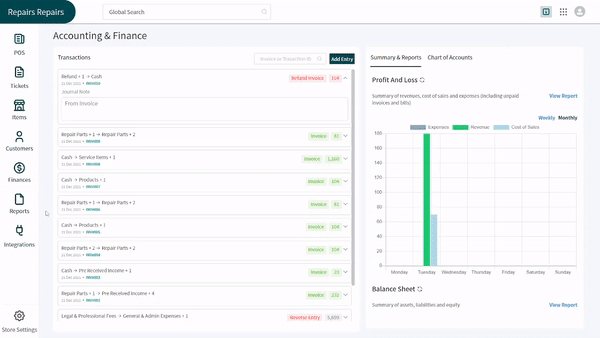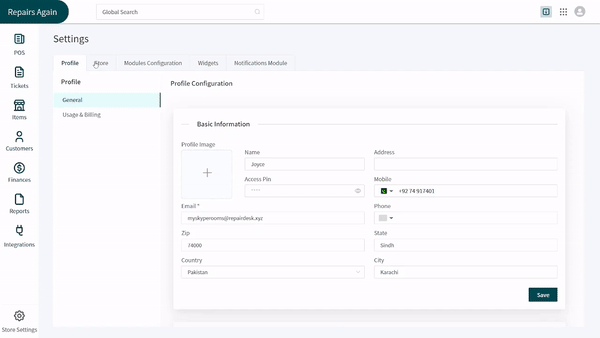Revision: 05d3f57311
Edited Automated Entries
@@ -1,4 +1,4 @@
-RepairDesk is always working on offering you smarter solutions requiring the least human involvement. This has inspired us to design finance and accounting module able of fetching data from invoices, receipts, refunds, and other finance streams.
+RepairDesk is always working on offering you smarter solutions requiring the least human involvement. This has inspired us to design finance and accounting module able of fetching data from invoices, receipts, refunds, cash-in and cash-out activities in the registers and other finance streams.
Automated Fetching in Accounts
------------------------------
@@ -10,6 +10,89 @@
1. Whenever you make an invoice against a repair service or sell a device, an entry for the finance and accounting section is made.
2. Clicking on an entry opens the breakdown of double entries on the right side of the screen.
3. Similarly, an entry is created for refunds and the breakdown can be accessed by clicking on it.
-4. It must be noticed that an automated entry can neither be reverted, edited nor deleted.
+4. The cash register activities like cash-in and cash-out are also logged in this module as entries. The detailed breakdown of each entry can be fetched by clicking on it.
+5. It must be noticed that an automated entry can neither be reverted, edited nor deleted.

+
+What Does RepairDesk Offers You in Automated Entries?
+-----------------------------------------------------
+
+RepairDesk offers you to map all your accounting and finance related necessary details on Chart of Accounts. Sub-types for the accounts are already made for the ease of the repair shop owners. However, they can make new account sub-types and edit the manually-made sub-types if they want. Here is how we have mapped your repair shop’s cash inflow and outflow on the account sub-types at hand:
+
+### Expenses → (Debit +, Credit -)
+
+The nature of expenses is considered **debit**. In case of adding expenses, debit is taken as positive while the credit is taken as negative. Here are the entries that are logged automatically (and manually) while the remaining ones have to be added manually only.
+
+1. General & Admin Expenses -> (Hit by Cash Out)
+2. Sales & Commission → (Hit by Commission)
+3. Refund → (Hit by automatic commission refund)
+4. Bad Debts → (Hit by remaining balance for RMA refund and credit note)
+5. Inventory Loss → (Items marked as Faulty)
+
+### Revenue → (Credit +, Debit -)
+
+The **credit** is taken as positive and debit is taken as negative while logging revenue from invoices. Here are the entries that are logged automatically (and manually) when an invoice is created or refunded.
+
+1. Products
+2. Repair Parts
+3. Service Items
+4. Special Ordered Items
+5. Buy Backs
+6. Refunds
+
+### Cost of Sales → (Debit +, Credit -)
+
+In case of COGs, **debit** is taken as positive while the credit is taken as negative. Here are the entries that are logged automatically (and manually as well) when selling the items with cost price.
+
+1. Products
+2. Repair Parts
+3. Special Ordered Items
+4. Buy Backs
+5. Refunds
+
+### Assets → (Debit +, Credit -)
+
+In case of assets, **debit** is taken as positive while the credit is taken as negative. Here are the sub-headers and the entries that can be logged automatically (and manually) while the remaining ones have to be added manually only.
+
+**Current Assets**
+
+1. Account Receivable
+2. Cash and Bank
+3. Cash in Hands (Cash in Petty, Cash)
+4. Integrated Payments (RepairDesk Pay)
+5. Inventory (Balanced Entry for PO / GRN)
+6. Tax Assets (Purchase Order Tax)
+7. Stock In Transit (PO created but Item not received)
+8. Credit Notes
+
+### Liabilities → (Credit +, Debit -)
+
+In case of liabilities, the **credit** is taken as positive while the debit is taken as negative while. Here are the entries that are logged automatically (and manually as well), while the remaining ones have to be added manually only.
+
+**Current Liabilities**
+
+1. Account Payable
+2. Taxes Payable
+3. Pre Received Income (The Automatic Entry is logged in case of Deposits)
+
+### Equity → (Credit +, Debit -)
+
+In case of equity, debit is taken as negative while the **credit** is taken as positive. All entries here are to be logged manually except for the listed below.
+
+1. Retained Earnings (Total Previous Profit excluding Current / Selected Date)
+2. Net Income (Current date's net profit -> Automatic only)
+
+
+
+Payment Method Linking with Account Type
+----------------------------------------
+
+You can link a payment method with an account type as well. All you have to do is reach to the module of **[Payment Methods](https://docs.repairdesk.co/lock_/payment_methods)** and follow the steps below:
+
+1. Begin with either adding a new payment method or open a pre-existing payment method for editing.
+2. Open the dropdown of **Account Type** by clicking on it.
+3. Select the account type you want to associate with the payment method from the options given.
+4. Click on the **Save** button at the bottom right corner to save changes.
+
+